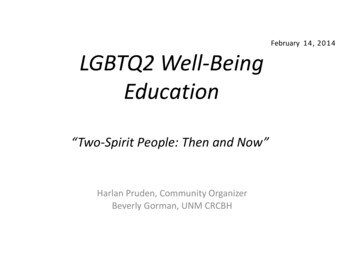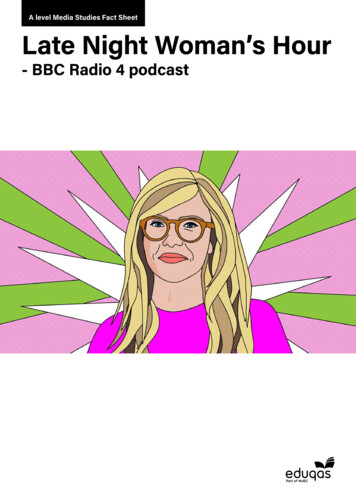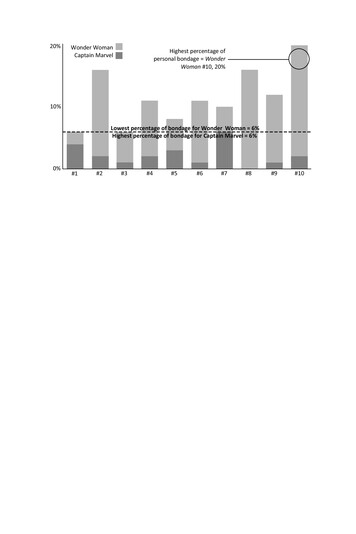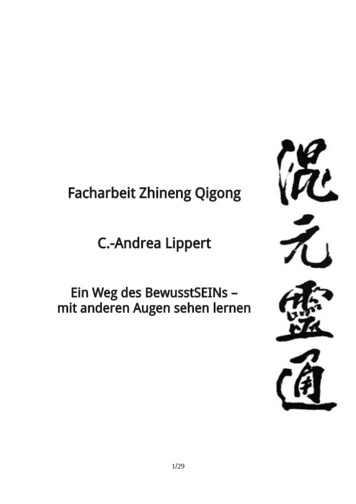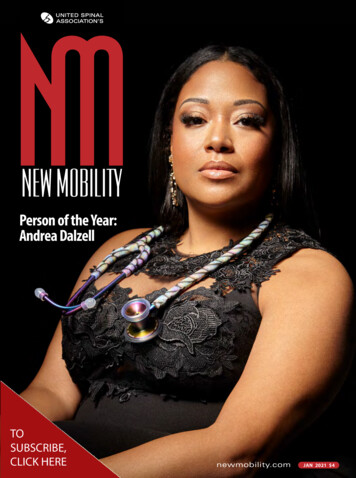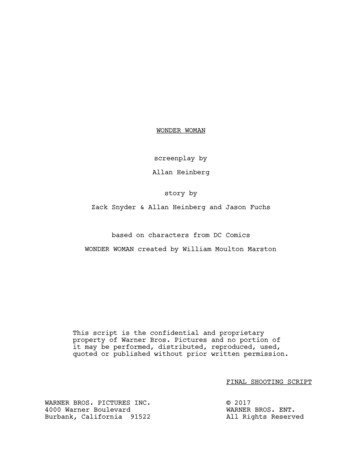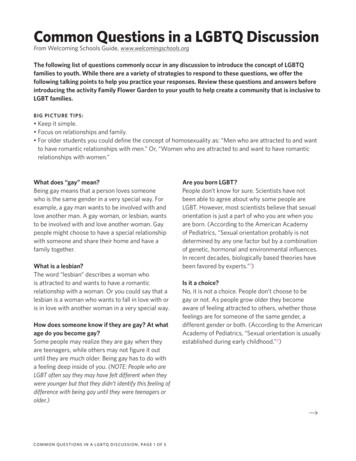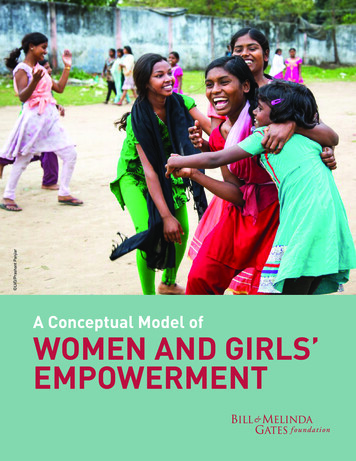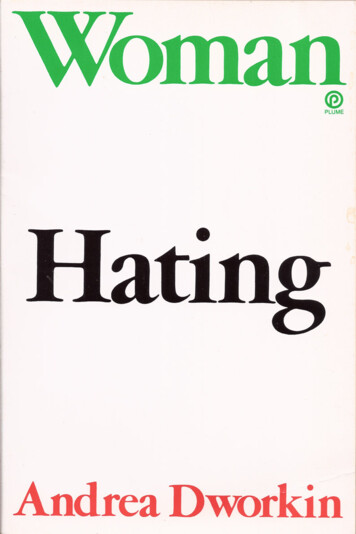
Transcription
PLUMEPublished by the Penguin GroupPenguin Books USA Inc., 375 Hudson Street,New York, New York 10014, U.S.A.Penguin Books Ltd, 27 Wrights Lane, London W8 5TZ, EnglandPenguin Books Australia Ltd, Ringwood, Victoria, AustraliaPenguin Books Canada Ltd, 10 Alcorn Avenue, Toronto, Ontario, Canada,M4V 3B2Penguin Books (N.Z.) Ltd, 182-190 Wairau Road, Auckland 10, New ZealandPenguin Books Ltd, Registered Offices: Harmondsworth, Middlesex, EnglandPublished by Plume, an imprint of New American Library, a division ofPenguin Books USA Inc.10 9 8 7 6 5 4 3Copyright 1974 by Andrea DworkinAll rights reservedPrinted in the United States of AmericaDrawing on page 98 by Jean HolabirdWithout limiting the rights under copyright reserved above, no part of thispublication may be reproduced, stored in or introduced into a retrieval system, ortransmitted, in any form, or by any means (electronic, mechanical, photocopy ing, recording, or otherwise), without the prior written permission of both thecopyright owner and the above publisher of this book.BOOKS ARE AVAILABLE AT QUANTITY DISCOUNTS WHEN USED TO PROMOTE PRODUCTSOR SERVICES. FOR INFORMATION PLEASE WRITE TO PREMIUM MARKETING DIVISION,PENGUIN BOOKS USA INC., 3 75 HUDSON STREET, NEW YORK, NEW YORK IOOI4.Permissions are on page218
For Grace Paleyand in Memory o f Emma Goldman. . . Shakespeare had a sister; but do notlook for her in Sir Sidney Lee’s life of thepoet. She died young —alas, she neverwrote a word. . . Now my belief is thatthis poet who never wrote a word and wasburied at the crossroads still lives. She livesin you and in me, and in many other wom en who are not here tonight, for they arewashing up the dishes and putting thechildren to bed. But she lives; for greatpoets do not die; they are continuing pres ences; they need only the opportunity towalk among us in the flesh. This opportu nity, as I think, it is now coming withinyour power to give her. For my belief isthat if we live another century or so—Iam talking of the common life which is thereal life and not of the little separate liveswhich we live as individuals —and havefive hundred a year each of us and roomsof our own; if we have the habit of free dom and the courage to write exactly whatwe think; if we escape a little from thecommon sitting-room and see human be ings not always in their relation to eachother but in relation to reality. . . if weface the fact, for it is a fact, that there isno arm to cling to, but that we go alone andthat our relation is to the world of reality. . . then the opportunity will come and thedead poet who was Shakespeare’s sisterwill put on the body which she has so often
laid down. Drawing her life from the livesof the unknown who were her forerun ners, as her brother did before her, shewill be born. As for her coming withoutthat preparation, without that effort onour part, without that determination thatwhen she is born again she shall find it pos sible to live and write her poetry, that wecannot expect, for that would be impos sible. But I maintain that she would comeif we worked for her, and that so to work,even in poverty and obscurity, is worth while.Virginia Woolf,A Room of One's Own (1929)
ACKNOWLEDGMENTRicki Abrams and I began writing this book together inAmsterdam, Holland, in December 1971. We workedlong and hard and through a lot o f living and then, formany reasons, our paths separated. Ricki went to Aus tralia, then to India. I returned to Amerika. So thebook, in its early pieces and fragments, became mine asthe responsibility for finishing it became mine. I thankRicki here for the work we did together, and the timewe had together, and this book which came from thattime and grew beyond it.Andrea Dworkin
CONTENTSIntroduction17Part One: THE FAIRY TALES29Chapter 1 Onceuponatime: The RolesChapter 2 Onceuponatime: The Moral of theStoryPart Two: THE PORNOGRAPHYChapter 3 Woman as Victim: Story of OChapter 4 Woman as Victim: The ImageChapter 5 Woman as Victim: SuckPart Three: THE HERSTORYChapter 6 Gynocide: Chinese FootbindingChapter 7 Gynocide: The WitchesPart Four: ANDROGYNYChapter 8 Androgyny: The Mythological ModelChapter 9 Androgyny: Androgyny, Fucking, 97Notes205Bibliography211
There is a misery of the body and a miseryof the mind, and if the stars, whenever welooked at them, poured nectar into ourmouths, and the grass became bread, wewould still be sad. We live in a system thatmanufactures sorrow, spilling it out of itsmill, the waters of sorrow, ocean, storm,and we drown down, dead, too soon. . . uprising is the reversal of the sys tem, and revolution is the turning of tides.Julian Beck, The Life of the Theatre
The Revolution is not an event that takestwo or three days, in which there is shoot ing and hanging. It is a long drawn outprocess in which new people are created,capable of renovating society so that therevolution does not replace one elite withanother, but so that the revolution createsa new anti-authoritarian structure withanti-authoritarian people who in theirturn re-organize the society so that itbecomes a non-alienated human society,free from war, hunger, and exploitation.Rudi DutschkeMarch 7, 1968
You do not teach someone to count onlyup to eight. You do not say nine and tenand beyond do not exist. You give peopleeverything or they are not able to count atall. There is a real revolution or none atall.Pericles Korovessis, in an interviewin Liberation, June 1973
INTRODUCTIONThis book is an action, a political action where revolu tion is the goal. It has no other purpose. It is notcerebral wisdom, or academic horseshit, or ideas carvedin granite or destined for immortality. It is part o f aprocess and its context is change. It is part o f a plane tary movement to restructure community forms andhuman consciousness so that people have power overtheir own lives, participate fully in community, live indignity and freedom.T he commitment to ending male dominance as thefundamental psychological, political, and cultural real ity o f earth-lived life is the fundamental revolutionarycommitment. It is a commitment to transformation o fthe self and transformation o f the social reality on everylevel. T h e core o f this book is an analysis o f sexism (thatsystem o f male dominance), what it is, how it operateson us and in us. However, I do want to discuss brieflytwo problems, tangential to that analysis, but still crucialto the development o f revolutionary program and con sciousness. T h e first is the nature o f the women’s move ment as such, and the second has to do with the work o fthe writer.17
10Woman HatingUntil the appearance of the brilliant anthologySisterhood Is Powerful and Kate Millett’s extraordinarybook Sexual Politics, women did not think o f themselvesas oppressed people. Most women, it must be admitted,still do not. But the women’s movement as a radicalliberation movement in Amerika can be dated from theappearance of those two books. We learn as we reclaimour herstory that there was a feminist movement whichorganized around the attainment of the vote forwomen. We learn that those feminists were also ardentabolitionists. Women “came out” as abolitionists —outof the closets, kitchens, and bedrooms; into publicmeetings, newspapers, and the streets. Two activistheroes o f the abolitionist movement were Black women,Sojourner Truth and Harriet Tubman, and they standas prototypal revolutionary models.Those early Amerikan feminists thought that suf frage was the key to participation in Amerikan democ racy and that, free and enfranchised, the former slaveswould in fact be free and enfranchised. Those womendid not imagine that the vote would be effectively de nied Blacks through literacy tests, property qualifica tions, and vigilante police action by white racists. Nordid they imagine the “separate but equal” doctrine andthe uses to which it would be put.Feminism and the struggle for Black liberation wereparts of a compelling whole. That whole was called,ingenuously perhaps, the struggle for human rights.The fact is that consciousness, once experienced, cannotbe denied. Once women experienced themselves as ac tivists and began to understand the reality and meaningof oppression, they began to articulate a politically
Introduction19conscious feminism. T heir focus, their concrete ob jective, was to attain suffrage for women.T h e women’s movement formalized itself in 1848 atSeneca Falls when Elizabeth Cady Stanton and LucretiaMott, both activist abolitionists, called a convention.T hat convention drafted The Seneca Falls Declaration ofRights and Sentiments which is to this day an outstandingfeminist declaration.In struggling for the vote, women developed manyo f the tactics which were used, almost a century later,in the Civil Rights Movement. In order to change laws,women had to violate them. In order to change con vention, women had to violate it. T he feminists (suf fragettes) were militant political activists who used thetactics o f civil disobedience to achieve their goals.T he struggle for the vote began officially with theSeneca Falls Convention in 1848. It was not untilAugust 26, 1920, that women were given the vote by thekindly male electorate. Women did not imagine that thevote would scarcely touch on, let alone transform, theirown oppressive situations. Nor did they imagine thatthe “separate but equal” doctrine would develop asa tool o f male dominance. Nor did they imagine theuses to which it would be put.T here have also been, always, individual feminists —women who violated the strictures o f the female role,who challenged male supremacy, who fought for theright to work, or sexual freedom, or release from thebondage o f the marriage contract. Those individualswere often eloquent when they spoke o f the oppressionthey suffered as women in their own lives, but otherwomen, properly trained to their roles, did not listen.
20Woman HalingFeminists, most often as individuals but sometimes insmall militant groups, fought the system which op pressed them, analyzed it, were jailed, were ostracized,but there was no general recognition among womenthat they were oppressed.In the last 5 or 6 years, that recognition has becomemore widespread among women. We have begun to un derstand the extraordinary violence that has been doneto us, that is being done to us: how our minds areaborted in their development by sexist education; howour bodies are violated by oppressive grooming im peratives; how the police function against us in casesof rape and assault; how the media, schools, andchurches conspire to deny us dignity and freedom; howthe nuclear family and ritualized sexual behavior im prison us in roles and forms which are degrading to us.We developed consciousness-raising sessions to try tofathom the extraordinary extent of our despair, to tryto search out the depth and boundaries of our inter nalized anger, to try to find strategies for freeing our selves from oppressive relationships, from masochismand passivity, from our own lack of self-respect. Therewas both pain and ecstasy in this process. Womendiscovered each other, for truly no oppressed grouphad ever been so divided and conquered. Women be gan to deal with concrete oppressions: to become partof the economic process, to erase discriminatory laws,to gain control over our own lives and over our ownbodies, to develop the concrete ability to survive on ourown terms. Women also began to articulate structuralanalyses o f sexist society — Millett did that with SexualPolitics; in Vaginal Politics Ellen Frankfort demonstrated
Introduction21the complex and deadly antiwoman biases o f the medi cal establishment; in Women and Madness Dr. PhyllisChesler showed that mental institutions are prisons forwomen who rebel against society’s well-defined femalerole.We began to see ourselves clearly, and what we sawwas dreadful. We saw that we were, as Yoko O no wrote,the niggers o f the world, slaves to the slave. We sawthat we were the ultimate house niggers, ass-licking,bowing, scraping, shuffling fools. We recognized all o four social behavior as learned behavior that functionedfor survival in a sexist world: we painted ourselves,smiled, exposed legs and ass, had children, kepthouse, as our accommodations to the reality o f powerpolitics.Most o f the women involved in articulating the op pression o f women were white and middle class. Wespent, even if we did not earn or control, enormoussums o f money. Because o f our participation in the middle-class lifestyle we were the oppressors o f otherpeople, our poor white sisters, our Black sisters, ourChicana sisters —and the men who in turn oppressedthem. This closely interwoven fabric o f oppression,which is the racist class structure o f Amerika today,assured that wherever one stood, it was with at least onefoot heavy on the belly o f another human being.As white, middle-class women, we lived in the houseo f the oppressor-of-us-all who supported us as heabused us, dressed us as he exploited us, “treasured”us in payment for the many functions we performed.We were the best-fed, best-kept, best-dressed, mostwilling concubines the world has ever known. We had
22Woman Hatingno dignity and no real freedom, but we did have goodhealth and long lives.The women’s movement has not dealt with thisbread-and-butter issue, and that is its most awfulfailure. There has been little recognition that the de struction of the middle-class lifestyle is crucial to thedevelopment of decent community forms in which allpeople can be free and have dignity. T here is certainlyno program to deal with the realities of the class systemin Amerika. On the contrary, most of the women’smovement has, with appalling blindness, refused to takethat kind o f responsibility. Only the day-care movementhas in any way reflected, or acted pragmatically on, theconcrete needs of all classes of women. The anger atthe Nixon administration for cutting day-care funds isnaive at best. Given the structure o f power politics andcapital in Amerika, it is ridiculous to expect the federalgovernment to act in the interests o f the people. Themoney available to middle-class women who identifyas feminists must be channeled into the programs wewant to develop, and we must develop them. In general,middle-class women have absolutely refused to take anyaction, make any commitment which would interferewith, threaten, or significantly alter a lifestyle, a livingstandard, which is moneyed and privileged.The analysis of sexism in this book articulatesclearly what the oppression o f women is, how it func tions, how it is rooted in psyche and culture. But thatanalysis is useless unless it is tied to a political con sciousness and commitment which will totally redefinecommunity. One cannot be free, never, not ever, in anunfree world, and in the course o f redefining family,
Introduction23church, power relations, all the institutions which in habit and order our lives, there is no way to hold ontoprivilege and comfort. T o attempt to do so is destruc tive, criminal, and intolerable.T h e nature o f women’s oppression is unique: womenare oppressed as women, regardless o f class or race;some women have access to significant wealth, but thatwealth does not signify power; women are to be foundeverywhere, but own or control no appreciable ter ritory; women live with those who oppress them, sleepwith them, have their children—we are tangled, hope lessly it seems, in the gut o f the machinery and way o flife which is ruinous to us. And perhaps most importantly, most women have little sense o f dignity or selfrespect or strength, since those qualities are directlyrelated to a sense o f manhood. In Revolutionary Suicide,Huey P. Newton tells us that the Black Panthers did notuse guns because they were symbols o f manhood, butfound the courage to act as they did because they weremen. When we women find the courage to defend our selves, to take a stand against brutality and abuse, weare violating every notion o f womanhood we have everbeen taught. T h e way to freedom for women is boundto be torturous for that reason alone.T he analysis in this book applies to the life situa tions o f all women, but all women are not necessarilyin a state o f primary emergency as women. What I meanby this is simple. As a Jew in Nazi Germany, I would beoppressed as a woman, but hunted, slaughtered, as aJew. As a Native American, I would be oppressed asa squaw, but hunted, slaughtered, as a Native Am eri can. That first identity, the one which brings with it as
24Woman Hatingpart of its definition death, is the identity of primaryemergency. This is an important recognition because itrelieves us of a serious confusion. The fact, for instance,that many Black women (by no means all) experienceprimary emergency as Blacks in no way lessens the re sponsibility of the Black community to assimilate thisand other analyses of sexism and to apply it in their ownrevolutionary work.As a writer with a revolutionary commitment, I amparticularly pained by the kinds of books writers arewriting, and the reasons why. I want writers to writebooks because they are committed to the content ofthose books. I want writers to write books as actions. Iwant writers to write books that can make a differencein how, and even why, people live. I want writers towrite books that are worth being jailed for, worthfighting for, and should it come to that in this country,worth dying for.Books are for the most part in Amerika commercialventures. People write them to make money, to becomefamous, to build or augment other careers. Most Ameri kans do not read books—they prefer television. Aca demics lock books in a tangled web of mindfuck andabstraction. The notion is that there are ideas, then art,then somewhere else, unrelated, life. The notion is thatto have a decent or moral idea is to be a decent or moralperson. Because o f this strange schizophrenia, booksand the writing o f them have become embroidery on adying way o f life. Because there is contempt for theprocess o f writing, for writing as a way o f discoveringmeaning and truth, and for reading as a piece of thatsame process, we destroy with regularity the few serious
Introduction25writers we have. We turn them into comic-book figures,bleed them o f all privacy and courage and commonsense, exorcise their vision from them as sport, demandthat they entertain or be ignored into oblivion. And itis a great tragedy, for the work o f the writer has neverbeen more important than it is now in Amerika.Many see that in this nightmared land, language hasno meaning and the work o f the writer is ruined. Manysee that the triumph o f authoritarian consciousness isits ability to render the spoken and written word mean ingless—so that we cannot talk or hear each other speak.It is the work o f the writer to reclaim the language fromthose who use it to justify murder, plunder, violation.T he writer can and must do the revolutionary work o fusing words to communicate, as community.Those o f us who love reading and writing believethat being a writer is a sacred trust. It means telling thetruth. It means being incorruptible. It means not beingafraid, and never lying. Those o f us who love readingand writing feel great pain because so many peoplewho write books have become cowards, clowns, andliars. Those o f us who love reading and writing beginto feel a deadly contempt for books, because we seewriters being bought and sold in the market place — wesee them vending their tarnished wares on every streetcorner. T oo many writers, in keeping with the Am eri kan way o f life, would sell their mothers for a dime.T o keep the sacred trust o f the writer is simply torespect the people and to love the community. T o vio late that trust is to abuse oneself and do damage toothers. I believe that the writer has a vital function inthe community, and an absolute responsibility to the
26Woman Hatingpeople. I ask that this book be judged in that context.Specifically Woman Hating is about women andmen, the roles they play, the violence between them.We begin with fairy tales, the first scenarios of womenand men which mold our psyches, taught to us be fore we can know differently. We go on to pornog raphy, where we find the same scenarios, explicitlysexual and now more recognizable, ourselves, carnalwomen and heroic men. We go on to herstory —thebinding of feet in China, the burning o f witches inEurope and Amerika. There we see the fairy-tale andpornographic definitions of women functioning inreality, the real annihilation of real women —the crush ing into nothingness o f their freedom, their will, theirlives —how they were forced to live, and how they wereforced to die. We see the dimensions of the crime, thedimensions of the oppression, the anguish and miserythat are a direct consequence of polar role definition,of women defined as carnal, evil, and Other. We recog nize that it is the structure of the culture which engi neers the deaths, violations, violence, and we look foralternatives, ways of destroying culture as we know it,rebuilding it as we can imagine it.I write however with a broken tool, a language whichis sexist and discriminatory to its core. I try to make thedistinctions, not “history” as the whole human story, not“man” as the generic term for the species, not “man hood” as the synonym for courage, dignity, andstrength. But I have not been successful in reinventingthe language.This work was not done in isolation. It owes much toothers. I thank my sisters who everywhere are standing
Introduction27up, for themselves, against oppression. I thank my sis ters, the women who are searching into our commonpast, writing it so that we can know it and be proud. Ithank my sisters, these particular women whose workhas contributed so much to my own consciousness andresolve — Kate Millett, Robin Morgan, Shulamith Fire stone, Judith Malina, and Jill Johnston.I also thank those others who have, through theirbooks and lives, taught me so much —in particular,Allen Ginsberg, James Baldwin, Daniel Berrigan, JeanGenet, Huey P. Newton, Julian Beck, and TimothyLeary.I thank my friends in Amsterdam who were familyfor the writing o f much o f this book and who helpedme in very hard times.I thank Mel Clay who believed in this book from itsmost obscure beginnings, the editors o f Suck and inparticular Susan Janssen, Deborah Rogers, MartinDuberman, and Elaine Markson who has been wonder ful to me. I thank Marian Skedgell for her help andkindness. I thank Brian Murphy who tried to tell me along time ago that O was an oppressed person. Chapter3 is dedicated to Brian.I thank Karen Malpede and Garland Harris for theirsupport and help. I thank Joan Schenkar for pushingme a little further than I was willing, or able, to go.I thank Grace Paley, Karl Bissinger, KathleenNorris, and Muriel Rukeyser. Without their love andfriendship this work would never have been done.Without their examples o f strength and commitment,I do not know who I would be, or how.I thank my brother Mark and my sister-in-law Carol
28Woman Hatingfor their friendship, warmth, and trust. And I thankmy parents, Sylvia and Harry Dworkin, for their devo tion and support through all these years, which musthave seemed to them interminable, when their daugh ter was learning her craft. I thank them for raising mewith real caring and tenderness, for believing in me sothat I could learn to believe in myself.Andrea DworkinNew York City, July 1973
Part OneTHE FAIRY TALESYou cannot be free if you are containedwithin a fiction.Julian Beck, The Life of the Theatre
Once upon a time there was a wicked witch and hername wasLilithEveHagarJezebelDelilahPandoraJahiTam arand there was a wicked witch and she was also calledgoddess and her name wasKaliFatimaArtemisHeraIsisMaryIshtarand there was a wicked witch and she was also calledqueen and her name wasBathsheba31
32Woman traMedeaand there was a wicked witch and she was also calledwitch and her name wasJoanCirceMorgan le FayTiamatMaria LeonzaMedusaand they had this in common: that they were feared,hated, desired, and worshiped.When one enters the world of fairy tale one seekswith difficulty for the actual place where legend andhistory part. One wants to locate the precise momentwhen fiction penetrates into the psyche as reality, andhistory begins to mirror it. Or vice versa. Womenlive in fairy tale as magical figures, as beauty, danger,innocence, malice, and gr eed. In the personae of thefairy tale —the wicked witch, the beautiful princess,the heroic prince —we find what the culture would haveus know about who we are.The point is that we have not formed that ancientworld —it has formed us. We ingested it as childrenwhole, had its values and consciousness imprinted onour minds as cultural absolutes long before we were infact men and women. We have taken the fairy tales of
Woman Hating33childhood with us into maturity, chewed but still lyingin the stomach, as real identity. Between Snow-whiteand her heroic prince, our two great fictions, we neverdid have much o f a chance. At some point, the GreatDivide took place: they (the boys) dreamed o f mountingthe Great Steed and buying Snow-white from thedwarfs; we (the girls) aspired to become that object o fevery necrophiliac’s lust —the innocent, victimized Sleep ing Beauty, beauteous lump o f ultimate, sleeping good.Despite ourselves, sometimes unknowing, sometimesknowing, unwilling, unable to do otherwise, we act outthe roles we were taught.Here is the beginning, where we learn who we mustbe, as well as the moral o f the story.
CHAPTER 1Onceuponatime: The RolesDeath is that remedy all singers dream ofAllen GinsbergThe culture predetermines who we are, how we behave,what we are willing to know, what we are able to feel.We are bom into a sex role which is determined byvisible sex, or gender.We follow explicit scenarios of passage from birthinto youth into maturity into old age, and then we die.In the process of adhering to sex roles, as a directconsequence o f the imperatives of those roles, we com mit homicide, suicide, and genocide.Death is our only remedy. We imagine heaven.There is no suffering there, we say. There is no sexthere, we say. We mean, there is no culture there.We mean, there is no gender there. We dream thatdeath will release us from suffering—from guilt, sex,the body. We recognize the body as the source of oursuffering. We dream of a death which will mean free dom from it because here on earth, in our bodies,we are fragmented, anguished—either men or women,bound by the very fact of a particularized body to a rolewhich is annihilating, totalitarian, which forbids us anyreal self-becoming or self-realization.Fairy tales are the primary information of the cul ture. They delineate the roles, interactions, and valueswhich are available to us. They are our childhood34
Onceuponatime: The Roles35models, and their fearful, dreadful content terrorizesus into submission — if we do not become good, then evilwill destroy us; if we do not achieve the happy ending,then we will drown in the chaos. As we grow up, weforget the terror—the wicked witches and their smother ing malice. We remember romantic paradigms: theheroic prince kisses Sleeping Beauty; the heroic princesearches his kingdom to find Cinderella; the heroicprince marries Snow-white. But the terror remains asthe substratum o f male-female relation — the terrorremains, and we do not ever recover from it or cease tobe motivated by it. Grown men are terrified o f thewicked witch, internalized in the deepest parts o f mem ory. Women are no less terrified, for we know that notto be passive, innocent, and helpless is to be activelyevil.Terror, then, is our real theme.The Mother as a Figure of TerrorWhether “instinctive” or not, the ma ternal role in the sexual constitution origi nates in the fact that only the woman isnecessarily present at birth. Only thewoman has a dependable and easily iden tifiable connection to the child —a tie onwhich society can rely. This maternal feel ing is the root of human community.George Gilder, Sexual SuicideSnow-white’s biological mother was a passive, goodqueen who sat at her window and did embroidery.She pricked her finger one day —no doubt an event inher life —and 3 drops o f blood fell from it onto the
36Woman Hatingsnow. Somehow that led her to wish for a child “as whiteas snow, as red as blood, and as black as the wood of theembroidery frame.” 1 Soon after, she had a daughterwith “skin as white as snow, lips as red as blood, andhair as black as ebony.” 2 Then, she died.A year later, the king married again. His new wifewas beautiful, greedy, and proud. She was, in fact,ambitious and recognized that beauty was coin in themale realm, that beauty translated directly into powerbecause it meant male admiration, male alliance, maledevotion.The new queen had a magic mirror and she wouldask it: “Looking-glass upon the wall, Who is fairestof us all?” 3 And inevitably, the queen was the fairest(had there been anyone fairer we can presume that theking would have married her).One day the queen asked her mirror who the fairestwas, and the mirror answered: “Queen, you are fullfair, *tis true, But Snow-white fairer is than you.” 4Snow-white was 7 years old.The queen became “yellow and green with envy,and from that hour her heart turned against Snowwhite, and she hated her. And envy and pride like illweeds grew in her heart higher every day, until she hadno peace. . . ” 5Now, we all know what nations will do to achievepeace, and the queen was no less resourceful (she wouldhave made an excellent head o f state). She ordered ahuntsman to take Snow-white to the forest, kill her, andbring back her heart. The huntsman, an uninspiredgood guy, could not kill the sweet young thing, so
Ricki Abrams and I began writing this book together in Amsterdam, Holland, in December 1971. We worked long and hard and through a lot of living and then, for many reasons, our paths separated. Ricki went to Aus tralia, then to India. I returned to Amerika. So the book
